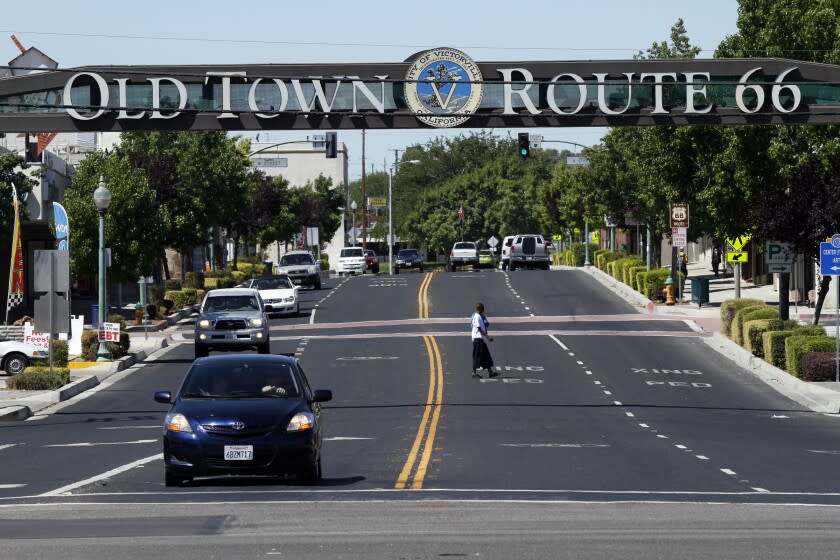Black students more harshly disciplined in Victor Valley high schools, feds say

The Victor Valley Union High School District disciplined Black students more harshly than others and has agreed to rectify its history of discriminatory practices, the U.S. Department of Education announced Tuesday.
The report by the department's Office for Civil Rights revealed one principal in the Inland Empire district told investigators that Black students are disciplined more because they are "loud" and it's their "culture." Another teacher told investigators that it was "a cultural thing" that "there seem to be a lot of African American kids who think fighting is a solution to everything."
The investigation, initiated in 2014, found that the district participated in a pattern of disciplining Black students more severely than white students for similar behavior. The investigation also found that the district failed to maintain and produce timely, accurate and complete records regarding school discipline.
The district said that even before the investigation was concluded, district officials "began taking steps to increase equity for our students.... We expect to see marked improvement in the discipline data for our students of color, particularly African-American students." The district said the report raised issues about "systemic problems" it is working to solve.
District administrators, teachers and students had reported the discriminatory practices, which took the forms of suspensions, expulsions, and truancy and law enforcement citations, according to a department statement.
Interviews with school staff revealed examples of the discriminatory behavior, outlined in a letter to the district. For instance, one administrator recounted the case of a Latina student who tased another student, was expelled for a semester and then allowed to return to school. A Black student who had acted threateningly toward a security officer, but was not violent, was expelled for more than one semester.
Some staff members expressed concern about a juvenile citation program called Clean Sweep. Operated by the San Bernardino County Sheriff's Department, the program allows administrators to write citations for students who break the law on campuses, requiring them to appear in juvenile court.
The investigation found that in the school year 2018-2019, the district was 3.4 times more likely to issue citations to Black students than to white students.
District leadership said in a memo that the communities affected by Clean Sweep were "already facing debilitating levels of poverty" and that the harm of issuing these citations, which could result in fines to the students' parents, was "unconscionable." The program was used at least between 2014 and 2019.
Other examples included Black students who were disciplined more harshly than white students for wearing sagging pants or not following the dress code.
Black students reported to investigators that they were monitored more often and more harshly by security officers on campus, and that pepper spray was used against them more often than against other students. The students said Latino students were not disciplined in the same way for being loud.
The district enrolled 13,769 students during the 2018-2019 school year, according to the report. About 65% were Latino. Black students made up about 21% and white students 8%. The most recent state data, for the 2021-2022 school year, showed enrollment had declined to 11,920 students. The Latino majority grew to 69%, Black student enrollment dropped to 17%, and white students declined to 7%.
As part of the settlement, the district agreed to revise its disciplinary policies and procedures, train its staff about the new policies and implement a "corrective action plan" to ensure students are treated fairly.
Additionally, the district agreed to employ a director to help with implementing the plan, publicly report discipline data and conduct school climate surveys to assess perceptions of fairness and safety.
"While these problems are not unique to VVUHSD, we recognize the seriousness of these issues and the importance of equity," said Kristopher Reilly, a spokesman for the district. "We are excited to make these positive changes based on the OCR's recommendations, in addition to our own previous work to break down inequities and improve student outcomes."
Reilly said the district has been working with a consultant and is assembling an equity committee as part of the agreement.
James Campbell, president of the Victor Valley NAACP branch, said he was contacted about joining the committee and is anticipating to be in talks with the district this school year. Campbell said he cannot comment on the findings of the report because he has not yet reviewed it.
"It definitely took me by surprise," he said of the investigation. "All I can say is we want to be able to figure it out. Anything involving the enrichment of our young people and our community, I'm all about that."
“I applaud the Victor Valley Union High School District’s commitment today to rectify the harms its discipline practices caused to Black students and to ensure nondiscrimination in school discipline going forward,” Catherine E. Lhamon, assistant secretary for civil rights at the Department of Education, said in a statement.
This story originally appeared in Los Angeles Times.

